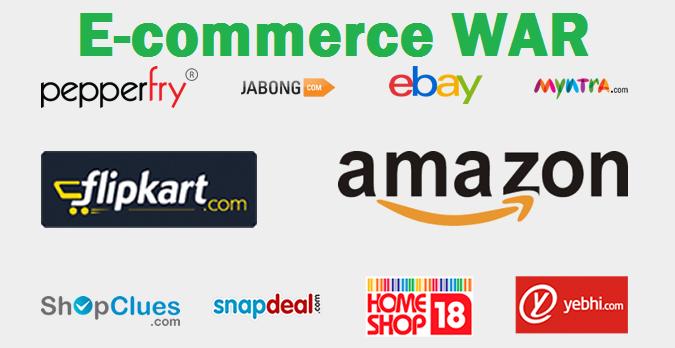
According to Report of Digital–Commerce, IAMAI-IMRB (2013), e-commerce industry in India has witnessed a growth of 34% year on year. The electronic commerce or commonly known as E-commerce, i.e. buying, selling or transmitting funds over internet, is the most talked about thing these days. The benefit of e-commerce includes its easy and twenty four by seven availability, a wider selection of goods and services, the speed of access, accessibility, and global reach. E-commerce businesses include practices of Etail, online marketplace; secure business transactions, B2B buying or selling and gathering and using demographic data through web contacts and social media. E-commerce further brings to the table vagaries in customer orders accompanied with difficult scenarios such as free delivery; order rescheduling, cancellation, returns and cash-on-delivery
Also Read : Why Retailer Should Track Competitors' Price
Retailers are prioritizing investment in e-commerce platforms above in-store IT systems, as businesses prepare for more high street store closures with the move to online, according to research. There are lot of players in the market and the biggest amongst them is Alibaba which had an e-commerce market share of 80% in China. Alibaba Group has the largest Initial public offering ever, worth $25 billion. Among emerging economies, China's e-commerce presence continues to expand every year. With 384 million internet users, China's online shopping sales rose to $36.6 billion in 2009 and one of the reasons behind the huge growth has been the improved trust level for shoppers.
India will have internet user base of about 300 million in December 2014. While the growth for eCommerce has been huge currently and will be more then US by 2015. About 70% of India's e-commerce market is travel related (airline tickets, railway tickets, hotel Bookings, online mobile recharge etc.). India has close to 10 million online shoppers and is growing at an estimated 30% CAGR vis-à-vis a global growth rate of 8–10%. Electronics and Apparel are the biggest categories in terms of sales. Evolution of the online marketplace model has been with sites like Jabong.com, Flipkart, Snapdeal, and Infibeam. Various industry estimates project that the sector will further growth five to seven times over the next four to five years. If this robust growth continues over the next few years, the size of the e-retail industry is poised to be 10 to 20 billion USD by 2017-2020. Recent years have seen a remarkable transformation in the way India shops and trades. E-commerce has taken the world of retail by storm and captivated the imagination of an entire generation of entrepreneurs, with e-commerce ventures with various business and commercial models.
Also Read : How Retailers Can Increase 46% in Revenue Using Pricing Intelligence
While Flipkart, amazon and Snapdeal are in a race to outdo one another in sales, what they have done, in effect, is grow India’s e-commerce market at breakneck speed over the last one year. Talking about top etailers and Indian e-commerce growth we give you a quick comparison that shows the status of them as of now. Amazon announced $2 billion investment to its India focused marketplace, Amazon.in, in July this year. Flipkart, raised $1 billion from Tiger Global Management and Naspers. SoftBank Internet and Media, Inc. (‘SIMI’) committed $627 million funding in New Delhi-based online marketplace, Snapdeal. Mukesh Bansal-led Myntra secured $50 million (about Rs.300 crore) investment. Fashion e-commerce major Jabong secured $27.5 million (Rs 173 crore) from British development finance institution CDC in a deal in February 2014.
While rounds of funding are seen everywhere another big thing happening are Mergers and Acquisitions. Led by the Rs 2,000-crore Flipkart-Myntra deals in May, the year recorded a 187 percent growth in overall M&A transactions, according to a VCC Edge report. Also, the size of PE/VC deals rose by 7 percent to $637 million from $592 million in 2013. Several other stories like Snapdeal – Yebhi, Homeshop18- inkfruit were seen. Now these happened because the phenomenal growth of the e-Commerce sector is accompanied by certain challenges as well like the absence of e-Commerce laws, low entry barriers leading to reduced competitive advantages, rapidly changing business models and customer loyalty etc.
Mobile commerce is the next logical step for Indian merchants. With the growth of mobile phones and increased issuing and use of debit and credit cards, mobile commerce will deliver strong growth over the coming years. Though this is already a platform to play for Amazon and Flipkart who have driven huge revenue from the mobile e-commerce yet there is further more potential to it. Social media networks such as Facebook are likely to increasingly become channels for sales and consumer engagement.
From the buyers perspective this has been a huge change for shopping goods, with options thronged on the web it’s difficult to understand which site should be chosen for which particular good to get the maximum value for money. Thus be the smart buyer and compare price @PriceTree before to buy anything online. PriceTree is India’s largest price comparison site wherein you can browse product from thousands of categories and find the best price online.
Related : Indian e-commerce ecosystem